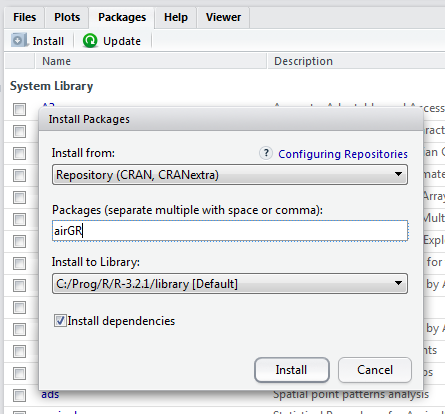airGR: the INRAE GR Hydrological Models in a R Package
Update: 2025-12-12
1 What is the airGR package?
1.1 Presentation
airGR is a package which brings into the R software the hydrological modelling tools used and developed at the Catchment Hydrology Research Group of INRAE (France), including the GR rainfall-runoff models that can be applied either on a lumped or semi-distributed way. A snow accumulation and melt model (CemaNeige) and the associated functions for the calibration and evaluation of models are also included. Each model core is coded in Fortran to ensure low computational time. The other package functions (i.e. mainly the calibration algorithm and the efficiency criteria calculation) are coded in R.
The airGR package has been designed to fulfill two major requirements: to facilitate the use by non-expert users and to allow flexibility regarding the addition of external criteria, models or calibration algorithms. The names of the functions and their arguments were chosen to this end. airGR also contains basics plotting facilities.
1.2 The airGR hydrological models
Seven hydrological models and one snow melt and accumulation model are implemented in airGR. The hydrological models can be applied either on a lumped way or on a semi-distributed way (on sub-catchments). The snow model can either be used alone or with the daily or hourly hydrological models. Naturally each hydrological model can also be used alone.
The models can be called within airGR using the following functions:
RunModel_GR4H(): four-parameter hourly lumped hydrological model (Mathevet 2005)RunModel_GR5H(): five-parameter hourly lumped hydrological model (Ficchi 2017; Ficchì, Perrin, and Andréassian 2019)RunModel_GR4J(): four-parameter daily lumped hydrological model (Perrin, Michel, and Andréassian 2003)RunModel_GR5J(): five-parameter daily lumped hydrological model (Le Moine 2008)RunModel_GR6J(): six-parameter daily lumped hydrological model (Pushpalatha et al. 2011)RunModel_GR2M(): two-parameter monthly lumped hydrological model (Mouelhi 2003; Mouelhi et al. 2006a)RunModel_GR1A(): one-parameter yearly lumped hydrological model (Mouelhi 2003; Mouelhi et al. 2006b)RunModel_CemaNeige(): two-parameter degree-day snowmelt and accumulation model (Valéry, Andréassian, and Perrin 2014; Riboust et al. 2019)RunModel_CemaNeigeGR4H(): combined use of GR4H and CemaNeigeRunModel_CemaNeigeGR5H(): combined use of GR5H and CemaNeige
RunModel_CemaNeigeGR4J(): combined use of GR4J and CemaNeigeRunModel_CemaNeigeGR5J(): combined use of GR5J and CemaNeigeRunModel_CemaNeigeGR6J(): combined use of GR6J and CemaNeige
The GRP forecasting model and the Otamin predictive uncertainty tool are not available in airGR.
2 Installation
You can install the package with the following command:
If you use RStudio, you can use the Packages interface :

You can download the airGR source, Windows binaries or Mac OS X binaries on the CRAN.
3 Misc
3.1 How to cite the package
To cite the package in your scientific document, please use the
references returned by the citation() function:
To cite airGR in publications use these two references:
Coron, L., Thirel, G., Delaigue, O., Perrin, C. and Andréassian, V. (2017). The Suite of Lumped
GR Hydrological Models in an R package. Environmental Modelling and Software, 94, 166-171, doi:
10.1016/j.envsoft.2017.05.002.
Coron, L., Delaigue, O., Thirel, G., Dorchies, D., Perrin, C. and Michel, C. (2025). airGR:
Suite of GR Hydrological Models for Precipitation-Runoff Modelling. R package version 1.7.8,
doi: 10.32614/CRAN.package.airGR.
To see these entries in BibTeX format, use 'print(<citation>, bibtex=TRUE)', 'toBibtex(.)', or set
'options(citation.bibtex.max=999)'.To retrieve a “.bib” format for LaTeX documents, you can use the following command:
@Article{,
title = {The Suite of Lumped {GR} Hydrological Models in an {R} package},
author = {L. Coron and G. Thirel and O. Delaigue and C. Perrin and V. Andréassian},
journal = {Environmental Modelling and Software},
year = {2017},
pages = {166-171},
volume = {94},
doi = {10.1016/j.envsoft.2017.05.002},
}
@Manual{,
title = {{airGR}: Suite of {GR} Hydrological Models for Precipitation-Runoff Modelling},
author = {L. Coron and O. Delaigue and G. Thirel and D. Dorchies and C. Perrin and C. Michel},
journal = {R News},
year = {2025},
note = {R package version 1.7.8},
doi = {10.32614/CRAN.package.airGR},
url = {https://CRAN.R-project.org/package=airGR},
}
